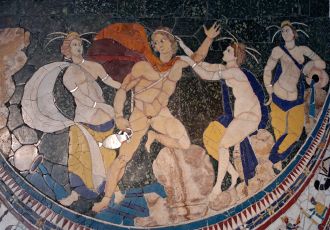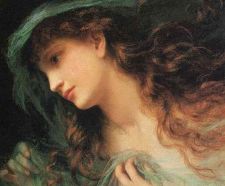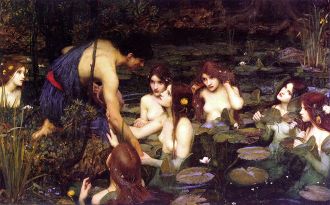Difference between revisions of "Nymph" - New World Encyclopedia
(fixed) |
m (Started) |
||
| Line 1: | Line 1: | ||
| − | {{Claimed}} | + | {{Claimed}}{{Started}} |
[[Category:Politics and social sciences]] | [[Category:Politics and social sciences]] | ||
[[Category:Anthropology]] | [[Category:Anthropology]] | ||
Revision as of 23:12, 28 May 2007
In Greek mythology, a nymph is any member of a large class of female nature entities, either bound to a particular location or landform or joining the retinue of a god, such as Dionysus, Hermes, or Pan, or a goddess, generally Artemis.[1] Nymphs were the frequent target of lusty satyrs.
Nymphs live in mountains and groves, by springs and rivers, and in valleys and cool grottoes. They are frequently associated with the superior divinities: the huntress Artemis; the prophetic Apollo; the reveller and god of wine, Dionysus; and rustic gods such as Pan and Hermes.
The symbolic marriage of a nymph and a patriarch, often the eponym of a people, is repeated endlessly in Greek origin myths; their union lent authority to the archaic king and his line.[citation needed]
Meaning of nymph
The Greek word νύμφη has "bride" and "veiled" among its meanings: hence a marriagable young woman. Other readers refer the word (and also Latin nubere and German Knospe) to a root expressing the idea of "swelling" (according to Hesychius, one of the meanings of νύμφη is "rose-bud").
Nymph classifications
The different types of nymph are sometimes distinguished according to the sphere of nature they inhabit and personify. Many of these distinctions however are perhaps late inventions. As Rose states, "all these names are simply feminine adjectives, agreeing with the substantive nympha, and there was no orthodox and exhaustive classification of these shadowy beings."[2] He mentions dryads and hamadryads as nymphs of trees generally, meliai as nymphs of ash trees, and naiads as nymphs of water, but no others specifically.[3]
The following is not the Greek classification, but is intended simply as a guide:
- Land Nymphs
- Alseids (glens, groves)
- Napaeae (mountain valleys, glens)
- Auloniads (pastures)
- Leimakids (meadows)
- Oreads (mountains, grottoes)
- Minthe (mint)
- Hesperides (garden)
- Aegle ("dazzling light")
- Arethusa
- Erytheia (or Eratheis)
- Hesperia (or Hispereia)
- Hespera (or Hespere)
- Hamadryads (trees)
- Water Nymphs
- Helead (fen)
- Oceanids (daughters of Oceanus and Tethys, any water, usually salty)
- Nereids (daughters of Nereus, the Mediterranean Sea)
- Naiads (usually fresh water)
- Crinaeae (fountains)
- Limnades or Limnatides (lakes)
- Pegaeae (springs)
- Potameides (rivers)
- Eleionomae (marshes)
- Wood Nymphs
- "Corycian Nymphs" (Classical Muses)
- Lampades (underworld)
Foreign adaptations
The Greek nymphs were spirits invariably bound to places, not unlike the Latin genius loci, and the difficulty of transferring their cult may be seen in the complicated myth that brought Arethusa to Sicily. In the works of the Greek-educated Latin poets, the nymphs gradually absorbed into their ranks the indigenous Italian divinities of springs and streams (Juturna, Egeria, Cavmentis, Fontus), while the Lymphae (originally Lumpae), Italian water-goddesses, owing to the accidental similarity of name, could be identified with the Greek Nymphae. The mythologies of classicizing Roman poets were unlikely to have affected the rites and cult of individual nymphs venerated by country people in the springs and clefts of Latium. Among the Roman literate class their sphere of influence was restricted, and they appear almost exclusively as divinities of the watery element.
Nymphs in modern Greek folklore
The ancient Greek belief in nymphs survived in many parts of the country into the early years of the twentieth century, when they were usually known as "nereids." At that time John Cuthbert Lawson wrote: "...there is probably no nook or hamlet in all Greece where the womenfolk at least do not scrupulously take precautions against the thefts and malice of the nereids, while many a man may still be found to recount in all good faith stories of their beauty, passion and caprice. Nor is it a matter of faith only; more than once I have been in villages where certain Nereids were known by sight to several persons (so at least they averred); and there was a wonderful agreement among the witnesses in the description of their appearance and dress."Cite error: Closing </ref> missing for <ref> tag
Stock stories about nereids include the girl who fell ill and died and was seen after death dancing with the nereids; the nereid changeling; and the man who won a nereid as his wife by stealing a piece of her clothing. The latter would become an ideal wife until she recovered her clothing and returned to her own people.[4]
Depictions in popular culture
Unlike mermaids, few nymphs have been depicted on film, in television, or in other forms of mass media and popular culture. Among them are:
- Nymphs appear frequently in fantasy fiction, including the Chronicles of Narnia by C.S. Lewis, the Xanth series by Piers Anthony, and The Belgariad by David Eddings
- Lady in the Water (2006), a film by M. Night Shyamalan, which features a water nymph (called a Narf) of a mythology he created for the movie.
- Nymph was the title of a pornographic movie, with Chasey Lain as a water nymph.
- Nymphs appear as creatures in the role-playing game Dungeons & Dragons and in many videogames, including EverQuest, Fable, Age of Wonders and Daggerfall.
- In The Tempest, Ariel appears as a water nymph in Act 1 Scene 2.
- Richard III longs "To strut before a wanton ambling nymph."
- The term nymphomaniac is derived from their name.
Notes
ReferencesISBN links support NWE through referral fees
- Rose, Herbert Jennings. 1959. A Handbook of Greek Mythology. New York, NY: E.P. Dutton & Co. ISBN 0525470417
- Lawson, John Cuthbert. 1910. Modern Greek Folklore and Ancient Greek Religion. Cambridge University Press.
- Tomkinson, John L. 2004. Haunted Greece: Nymphs, Vampires and other Exotika. Athens: Anagnosis. ISBN 9608808707
- [Nereids]
- Burkert, Walter. 1985. Greek Religion. Cambridge, MA: Harvard University Press. ISBN 0674362810
- This article incorporates text from the Encyclopædia Britannica Eleventh Edition, a publication now in the public domain.
- Lawson, John Cuthbert, Modern Greek Folklore and Ancient Greek Religion, Cambridge University Press, Cambridge, 1910 p131
- Tomkinson, John L., Haunted Greece: Nymphs, Vampires and other Exotika, Anagnosis, Athens, 2004, ISBN 960-88087-0-7
- Information page
Credits
New World Encyclopedia writers and editors rewrote and completed the Wikipedia article in accordance with New World Encyclopedia standards. This article abides by terms of the Creative Commons CC-by-sa 3.0 License (CC-by-sa), which may be used and disseminated with proper attribution. Credit is due under the terms of this license that can reference both the New World Encyclopedia contributors and the selfless volunteer contributors of the Wikimedia Foundation. To cite this article click here for a list of acceptable citing formats.The history of earlier contributions by wikipedians is accessible to researchers here:
The history of this article since it was imported to New World Encyclopedia:
Note: Some restrictions may apply to use of individual images which are separately licensed.


